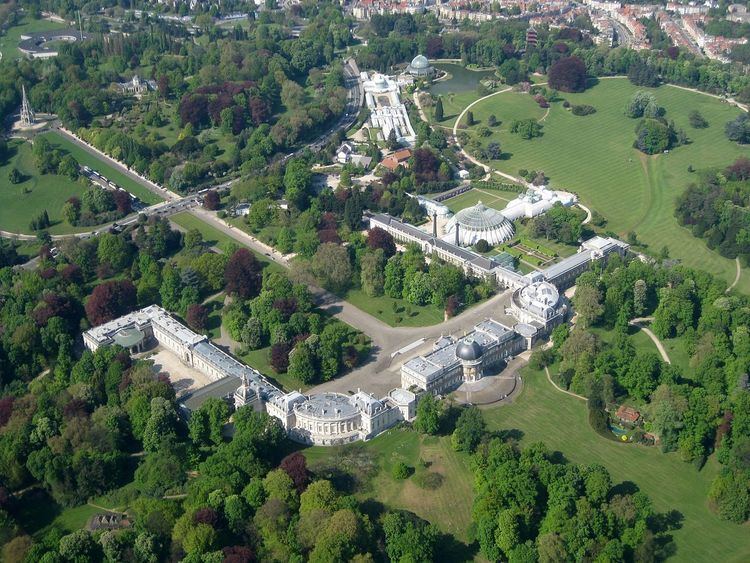Town or city Laeken (Brussels) Opened 1784 Owner Monarchy of Belgium Construction started 1782 | Country Belgium Phone +32 2 551 20 20 Engineer Louis Montoyer | |
 | ||
Client Governors of the Habsburg Netherlands, Archduchess Maria Christina of Austria and her husband Albert of Saxe-Teschen Address Avenue du Parc Royal, 1020 Bruxelles, Belgium Architects Charles de Wailly, Louis Montoyer Similar Royal Palace of Brussels, Royal Greenhouses of Laeken, Cathedral of St Michael a, Church of Our Lady of Laeken, Atomium | ||
Dung van meerbeeck serres royales de laeken royal greenhouses of laeken in belgium 2015
The Royal Castle of Laeken (Dutch: Kasteel van Laken, French: Château de Laeken) is the official residence of the King of the Belgians and the royal family. It lies in the Brussels region, 5 km (3 mi) north of the city centre in the Laeken neighbourhood. It sits in a large park called the Royal Domain of Laeken, which is off-limits to the public.
Contents
- Dung van meerbeeck serres royales de laeken royal greenhouses of laeken in belgium 2015
- History
- Royal Garden of Laeken
- Other
- References
The Castle at Laeken should not be confused with the Royal Palace of Brussels, in central Brussels, which is the official palace (not residence) of the King of the Belgians and from which affairs of state are handled.
History
The Castle was built at Laeken, then outside of Brussels, between 1782-1784 after the plans of the French architect Charles de Wailly under supervision of Louis Montoyer as a summer residence for the Governors of the Habsburg Netherlands, Archduchess Maria Christina of Austria and her husband Albert of Saxe-Teschen. Jean-Joseph Chapuis provided the royal furnitures.
On 21 July 1803, Nicolas-Jean Rouppe, as commissioner of the department of the Dijle, received Napoleon at the Castle of Laeken. Napoleon stayed at Laeken with the Empress Josephine in August 1804 on his way from awarding the first Légion d'honneur to his invasion troops at Boulogne to his progress along the Rhine, and later during the Hundred Days in 1815 dated this proclamation prematurely from the palace:
After Belgian independence, Rouppe, as mayor of Brussels, received the new king Leopold I at the Castle of Laeken on 21 July 1831; the day of Leopold's coronation. The palace was partly destroyed by fire in 1890 and was rebuilt by Alphonse Balat. The French architect Charles Girault gave it its present outline in 1902. It has been the royal residence since the Leopold I's accession to the throne in 1831. The domain also contains the magnificent Royal Greenhouses of Laeken, a set of monumental dome-shaped constructions, accessible to the public for only a few days each year. They were designed as well by Alphonse Balat, with the cooperation of the young Victor Horta.
Upon their accession to the throne in 1993, King Albert II and Queen Paola preferred to remain living at Belvédère, a château on the grounds of the park surrounding the Castle . The current occupants of the Castle are King Philippe, Queen Mathilde and their four children.
Royal Garden of Laeken
The royal estate is surrounded by an immense garden, that is protected by a stone wall of several kilometers. The gardens are designed in English style, the vast parks of the Royal Domain include lakes, a golf course and artworks. During the reign of Leopold II they had their major splendor. The king planted tress and was very close connected with the designs of his private gardens. In the gardens his only son , the duke of Brabant drowned in a lake. The king had trees planted for his new born children, and still stand in the park.
Various pavilions like the Chinese Pavilion and the Japanese Tower. The Chinese Pavilion was commissioned by King Leopold II and now forms part of the Museums of the Far East. The rooms are designed in a chinoiserie Louis XIV and Louis XVI Style. They are decorated with Chinese motifs, chinaware and silverware. The Japanese Tower is a pagoda, originally built for the World Fair of Paris in 1900.
Today only the king himself and his children use this garden, generally the gardens are closed for the public. Inside the gardens we can find an unique collection of old plants and biodiversity. Not only the Greenhouses but the garden too is famous for its unique varieties of animals and trees.
In the gardens several living colonies of wild Canadian goose, thousands of cormorants and other large birds live. The gardens are home to one of the biggest colonies of Herons of the country.
Other
Mobutu Sese Seko, the dictator of Zaire (the modern-day Democratic Republic of the Congo), built a palace in his hometown of Gbadolite modelled upon the Royal Castle of Laeken.
